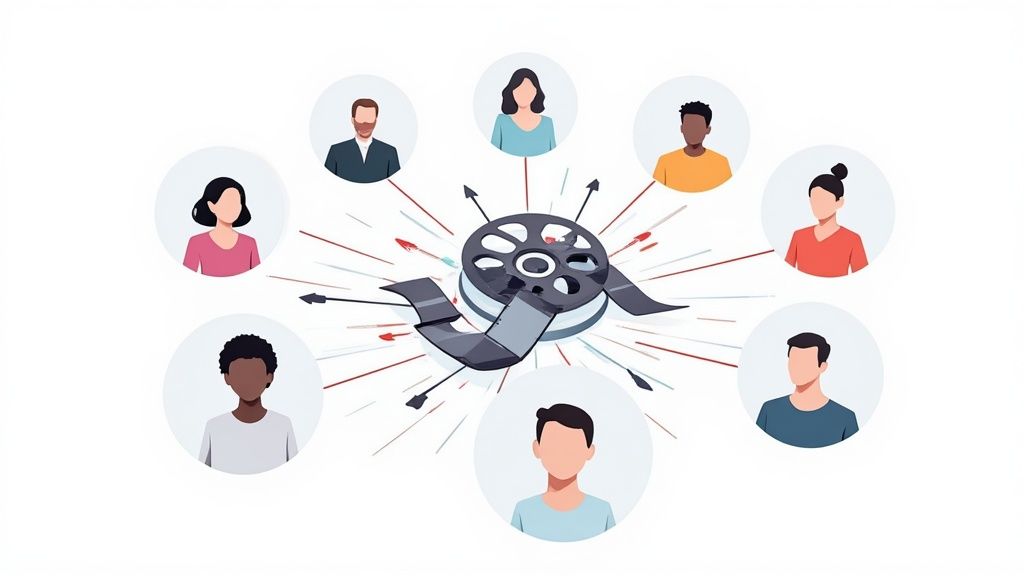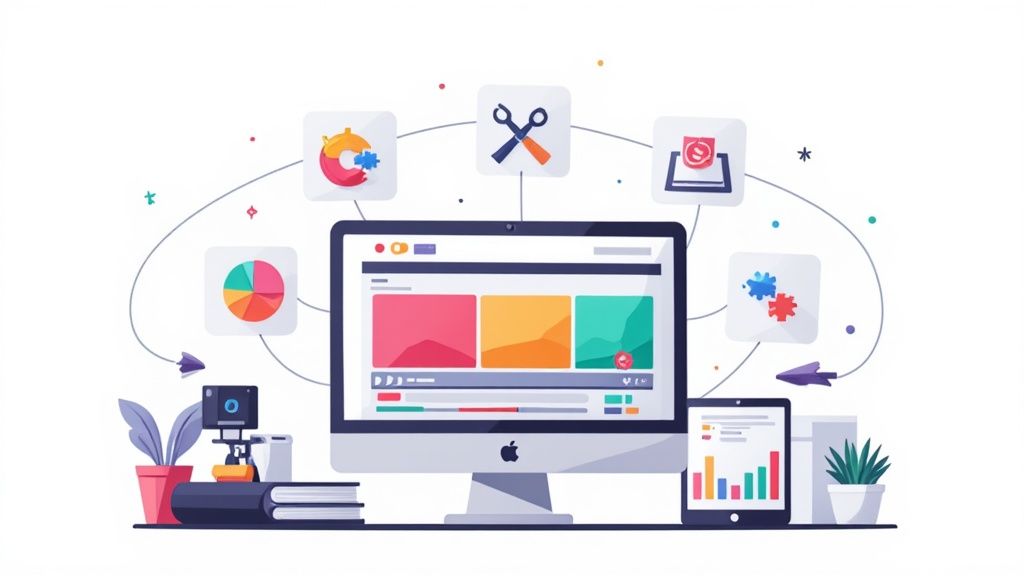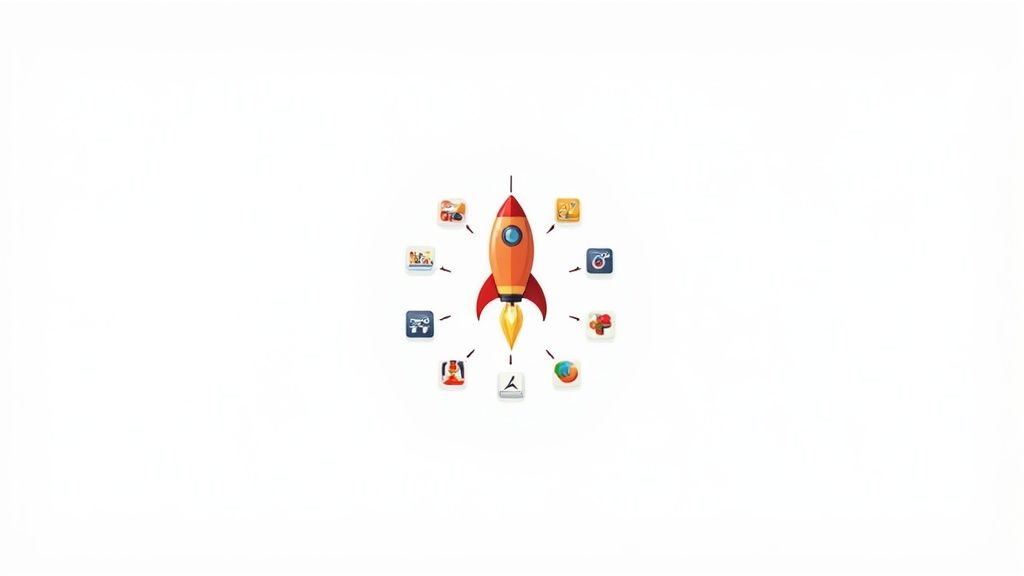Animated Business Videos That Convert



Imagine trying to boil down a complex software feature or a dense financial service into a 90-second pitch. It's a tall order. This is exactly where animated business videos come in, acting like a universal translator for your biggest ideas. They turn abstract concepts into simple, engaging stories that just about anyone can grasp.
Why Animated Business Videos Work
In a world drowning in digital noise, animation cuts through the clutter. It offers a visually unique and memorable way to grab—and hold—attention. Plus, you get to skip the expensive location shoots, actors, and logistical headaches, making it a flexible and often more affordable way to bring your vision to life.
But the real magic of animated business videos is their power to simplify.
Think about explaining how cloud computing works or the upside of a new investment tool. A live-action video would have a hard time showing these invisible processes. Animation, on the other hand, can bring data flows to life, illustrate abstract benefits, and make intangible services feel concrete and easy to understand.
The Science of Engagement and Retention
Animated content speaks the brain's language. By mixing visual and auditory cues—moving pictures and a clear voiceover—animation gives viewer retention a serious boost. People are far more likely to remember a message when it’s wrapped in a story with characters and scenarios they can relate to, and that's a format where animation truly excels.
This storytelling approach builds an emotional connection, which is the bedrock of brand trust. When a viewer watches a character grapple with a problem they recognize and then sees your product or service save the day, the message hits home. It becomes personal and powerful. This is a huge reason why explainer videos are so effective, something we explore in our guide on the benefits of explainer videos.
The market is definitely taking notice. The marketing animation video production market is set to grow from around $681.1 million in 2024 to nearly $3.36 billion by 2034. North America alone makes up about 34.5% of this market. This boom is fueled by the big shift to digital ads and the endless consumer appetite for video content. You can dig into more data about the growth of the animation market on market.us.
Let's quickly recap the core advantages that make animated videos such a valuable asset for businesses.
In short, these benefits work together to make your marketing more effective from top to bottom.
Versatility Across the Customer Journey
Another huge plus is just how incredibly versatile animation is. You can create a single animated asset and then tweak it for different touchpoints, ensuring a smooth and cohesive brand experience for your audience.
- Top of Funnel: Think short, punchy animated videos. They’re perfect for grabbing attention in social media ads and on landing pages, sparking that initial curiosity.
- Middle of Funnel: This is where detailed explainer videos come in handy. They can educate prospects, knock out common questions, and showcase what makes you unique, whether on your website or in an email nurturing sequence.
- Bottom of Funnel: Once you've made the sale, animated onboarding videos, tutorials, and internal training guides can boost customer happiness and get employees up to speed, strengthening those relationships for the long haul.
By speaking a universal visual language, animated videos break down barriers to understanding. They make your most complex ideas accessible, your brand more memorable, and your message more persuasive, paving the way for higher conversion rates and stronger customer connections.
The Strategic Power of Animation in Marketing
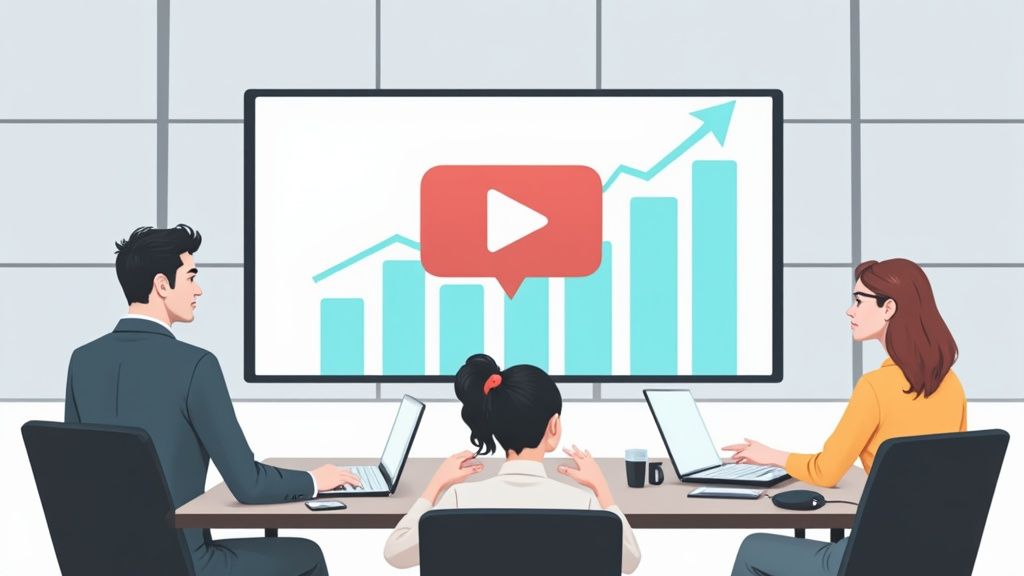
There's more to animation than just looking good. When used smartly, animated content becomes a serious powerhouse in any marketing toolkit. It has this unique way of getting under the skin, using characters and imaginative worlds to forge genuine emotional connections that live-action can sometimes struggle to match.
Think about it. Animation gives you total freedom to craft the perfect brand ambassador. This character doesn't have to be a real person, but they can perfectly capture your brand’s voice, speak directly to your audience's struggles, and present your solution without being tied to reality.
Building Emotional Connections Through Story
The real magic of animated business videos is their knack for storytelling. By shedding the literal constraints of the real world, animation can use metaphor and symbolism to explain abstract ideas or feelings in a way that just clicks. A simple animated character wrestling with a common problem can instantly create a powerful feeling of, "Hey, I've been there."
When viewers see their own challenges mirrored on screen and then watch your product or service save the day, the marketing message becomes personal and sticks with them. It’s no longer just a pitch; it’s an emotional journey that builds real brand loyalty.
This is why 78% of consumers say animated explainer videos helped them better understand a product. You can learn more about what an explainer video is and why it works in our detailed guide.
Unlocking Versatility and Cohesive Branding
One of the biggest wins with animation is its incredible versatility. A single, well-defined animated style can become the visual glue holding your entire brand together, creating a cohesive and instantly recognizable look across every channel.
Just imagine the possibilities:
- Marketing Campaigns: Your signature animation style can tie together social media ads, landing page videos, and email promotions for a truly unified campaign.
- Internal Training: Break down complex company policies or new software for your team with clear, engaging animated guides that feel consistent with your external brand.
- Sales Presentations: Give your sales team dynamic animated videos that explain your value proposition in a flash, leaving a lasting impression on potential clients.
When you establish a consistent animated identity, every touchpoint a customer has with your brand feels familiar and reinforcing. This kind of consistency is crucial for building trust and standing out in a crowded market.
Achieving a Compelling Return on Investment
Finally, let's talk about the bottom line. Animated business videos can deliver a fantastic return on investment (ROI). While high-end 3D can get pricey, many animation styles are significantly more cost-effective than live-action productions. You completely sidestep major expenses like scouting locations, hiring actors, building sets, and all the logistical headaches of an on-site shoot.
This efficiency is fueling some serious market growth. The global animated video market, valued at a massive $576.75 billion in 2024, is expected to skyrocket to $3.16 trillion by 2033. To get a piece of that pie, it's essential to stay on top of the evolving landscape of video content in marketing and make smart, strategic moves.
An animated video isn't a one-and-done deal; it's a durable asset. It typically has a longer shelf life, can be easily updated with new branding or information, and can be sliced and diced into countless smaller clips for social media. Every dollar you invest works that much harder for your brand.
Choosing the Right Animation Style for Your Brand

Picking the right animation style for your business isn't just about what looks cool—it's a strategic decision. Think of animation styles like different outfits. You wouldn't wear a tuxedo to a beach party, and you wouldn't wear board shorts to a black-tie gala. The right style makes sure your message isn't just seen, but felt in a way that clicks with your brand and your audience.
This choice is a huge deal. It directly shapes how people perceive your message. A playful, cartoony style can make a brand feel fun and approachable. On the other hand, sleek, minimalist graphics can signal sophistication and technical prowess. This decision is a core part of your animated business videos strategy, setting the entire tone for how customers connect with your story.
Aligning Style with Your Message and Audience
Before you go any further, take a moment for a gut check on three things: your brand's personality, your message's complexity, and what your audience expects to see. Are you a disruptive startup trying to shake things up, or an established, authoritative voice in your industry? The answer will point you toward a style that feels authentic, not forced.
Here’s a simple way to think about it:
- For Breaking Down Complex Ideas: Whiteboard animation is a classic for a reason. Its step-by-step, hand-drawn feel is fantastic for tutorials, educational topics, and process breakdowns. It feels instructive and clear, making it a go-to for training or how-to videos.
- For Data and Abstract Concepts: 2D motion graphics will be your best friend. This style is brilliant at bringing charts, graphs, and abstract ideas to life with clean lines and fluid movement. It's perfect for SaaS companies, financial services, or anyone who needs to make data compelling and easy to digest.
- For Storytelling and Emotional Connection: When you need to build empathy, nothing beats 2D character animation. By creating relatable characters, you can tell stories that resonate on a human level. This makes it a great choice for brand overview videos or campaigns focused on building trust. If you want to dive deeper, check out our detailed guide on 2D explainer videos and how they drive results.
- For Product Showcases and Immersive Worlds: 3D animation offers a sense of depth and realism that other styles just can't touch. It’s ideal for showing off a physical product from every angle or creating a tangible, lifelike world for things like architectural visualizations or high-impact product launches.
The demand for 3D is a huge trend right now. The global animation market was valued at an estimated $371.85 billion in 2024 and is expected to climb to $590.85 billion by 2033. The 3D animation segment is a massive driver of that growth, projected to expand at a rapid 11.7% CAGR. These numbers aren't just trivia; they show a clear market hunger for high-quality, immersive content. You can learn more about the latest animation industry statistics on motionplaystudio.com.
Practical Examples from Different Industries
So, how does this look in the real world? A fintech company explaining a new investment algorithm would likely lean on sharp, clean 2D motion graphics. The style itself reinforces the message: this is sleek, precise, and trustworthy.
A non-profit, however, might go a completely different route. To raise awareness for a social cause, they could use hand-drawn 2D character animation. By telling an emotional story through a character people can connect with, they can inspire action in a way that a list of statistics never could.
Your animation style is your brand's visual language. Choosing the right one ensures you are not just communicating information but also conveying the right emotion and building a stronger, more authentic connection with your audience.
Ultimately, the best animated business videos are the ones where the style, message, and brand voice all sing from the same sheet. Don't just pick what looks good. Pick what strategically serves your business goals and speaks directly to the people you’re trying to reach. That thoughtful approach is what turns a simple video into a truly powerful tool.
Your Animation Production Workflow From Idea to Final Cut
Turning a spark of an idea into a polished animated video can seem like a bit of a mystery. But it’s much more methodical than magic. Think of it like building a house: you need a solid blueprint and a clear set of steps to make sure the final result is sturdy, functional, and exactly what you dreamed of.
A well-defined production workflow takes the guesswork out of the equation. It creates a clear path with specific checkpoints for feedback, ensuring every decision—from the first word of the script to the final sound mix—lines up perfectly with your business goals. The whole journey can be broken down into five key phases, each one building on the last.
Phase 1: Discovery and Scriptwriting
This first stage is all about strategy. Before a single image is sketched, you have to get clear on the video's core purpose. What’s the one key message you need viewers to walk away with? Who, exactly, are you talking to, and what do you want them to do after they finish watching? Nailing these answers sets the direction for the entire project.
With a clear objective, the scriptwriting begins. This is, without a doubt, the most important part of your video. A great script tells a story, explains your value clearly, and guides the viewer on an emotional journey. For a standard 90-second video, you're looking at a script of about 225 words. Every single word has to earn its place.
Phase 2: Storyboarding and Animatics
Once the script is locked in, it's time to translate those words into visuals. The storyboard is a series of sketches, like a comic book version of your video, that maps out each scene. It shows character positions, camera angles, and key actions, making sure the visual story flows with the script.
Next up is the animatic. This is essentially a rough draft of the animation, where the storyboard sketches are timed out with a temporary voiceover or music. It gives you the first real feel for the video's pacing and rhythm, letting you make tweaks before the heavy lifting of illustration and animation starts. It's a crucial checkpoint to confirm the story is landing as intended.
Phase 3: Style Frames and Illustration
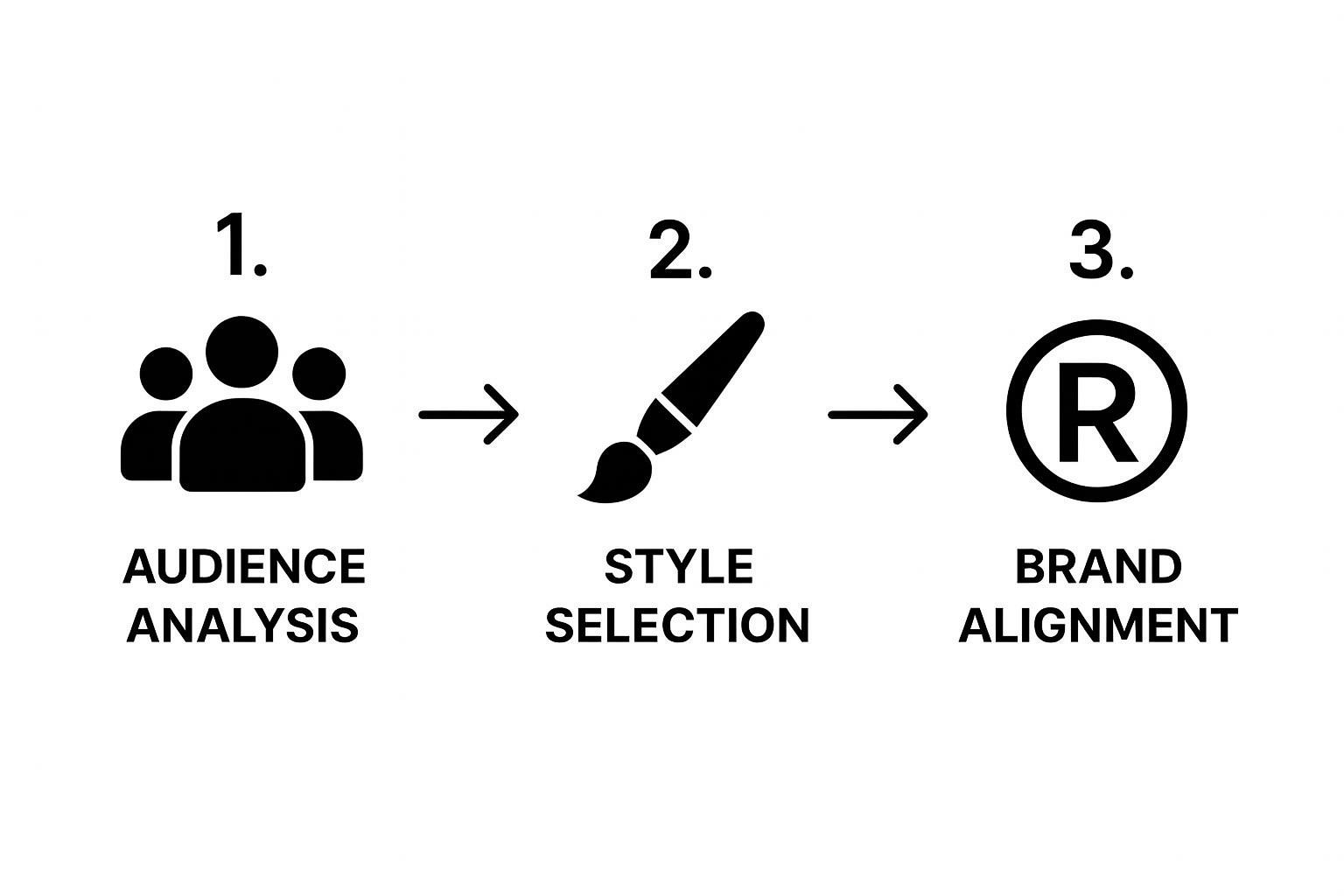
This is where your video’s visual personality really starts to shine. Style frames are a few high-quality, fully-colored still images from key moments in the video. They lock in the final look and feel—the color palette, character designs, and background details. Once these are approved, you know exactly how the final animation will look and that it aligns with your brand.
With the style approved, illustrators get to work creating every single visual asset needed. This means every character, prop, background, and icon that will appear is drawn and finalized. This becomes the complete visual library for the animators. It’s the last real chance to make any big visual changes before things are set in motion.
This infographic shows just how critical the foundational strategic steps are. Before you even think about animation style or creating a single asset, a deep understanding of your audience and brand is non-negotiable for success.
Phase 4: Animation and Sound Design
Here's where the magic happens. The animators take the approved illustrations and bring them to life, frame by frame. They meticulously animate characters, create smooth transitions, and add motion to the graphic elements, all following the blueprint laid out by the storyboard and animatic. This is often the most time-consuming part of the whole process.
At the same time, the sound design is finalized. This involves recording the professional voiceover, mixing in the perfect background music, and adding sound effects that punch up the on-screen action. Sound is a hugely powerful tool for setting the mood and pulling the viewer deeper into the story.
Phase 5: Final Delivery
In the home stretch, all the pieces come together. The final animation is rendered and perfectly synced with the professional audio track. The video gets one last look-over for any minor corrections. Once you give the final thumbs-up, the video is delivered in all the formats you need for your website, social media channels, and marketing campaigns.
While these five steps are specific to animation, the core idea of a structured process is universal. For a broader look at managing creative projects, you can check out guides on optimizing your content creation workflow. And if you're laser-focused on explainers, our guide on how to make an explainer video offers an even deeper dive into that specific process.
Creating High-Impact Animated Videos That Get Results
Knowing the steps to make an animated video is one thing. Actually creating one that gets real, measurable results? That’s a whole different ball game. It's the gap between just making a video and making one that truly moves the needle.
There are a few core principles that can elevate your animations from just "nice to watch" to genuinely persuasive. Think of these not as just creative add-ons, but as strategic choices that directly shape how people engage and, ultimately, convert. A high-impact video is one where every single element—from the script to the sound—is working in perfect harmony toward a specific business goal.
Craft a Compelling Narrative Under 90 Seconds
Let’s be honest: you have only a few seconds to grab someone's attention online. For most marketing videos, the sweet spot for length is somewhere between 60 and 90 seconds. This is just enough runway to hook the viewer with a problem, introduce your solution, and point them to the next step without them getting bored and clicking away.
Keeping it short forces you to be ruthless with your messaging. It’s like an elevator pitch—every second has to earn its place. If a line or a scene doesn't support your one core message, cut it. To really make an impact in this tight window, you need to master various visual storytelling techniques that pull your audience in from the first frame.
Prioritize a Professionally Written Script
The script is the skeleton of your entire video. It's the blueprint everything else is built on. A weak, confusing script will always lead to a weak, confusing video, no matter how slick the animation is. But a great script? It gives you a clear story, builds an emotional connection, and guides the viewer's journey.
A professional script does so much more than just lay out the dialogue. It dictates the visual flow, sets the pacing, and ensures the tone is a perfect match for your brand. Never, ever treat the script as an afterthought. It's the single most important piece of the puzzle.
Leverage High-Quality Voice and Sound
The audio experience is just as crucial as the visuals—some might argue even more so. A professional voice-over instantly adds a layer of credibility and polish that helps build trust. The right tone, pacing, and clarity from a voice actor can completely transform the mood and impact of your message.
But it’s not just about the voice. The sound design is what brings the animation to life.
- Background Music: This sets the emotional stage. Are you going for urgent and exciting, or calm and trustworthy? The music does a lot of the heavy lifting.
- Sound Effects (SFX): These little audio details add personality and make the on-screen action feel more real and dynamic. A simple swoosh or pop can make a world of difference.
A great video with bad audio will just be perceived as a bad video. Period. Investing in quality sound isn't optional; it's what separates amateur content from professional work that holds attention.
Design a Clear and Persuasive Call-to-Action
Okay, so your video grabbed their attention and kept them engaged. Now what? If you don't give them a clear next step, you're leaving them hanging. Your Call-to-Action (CTA) is the final, crucial instruction that tells them exactly what you want them to do, whether it's "Visit Our Website," "Schedule a Demo," or "Download the Guide."
Your CTA needs to be unmistakable, both visually and audibly. It should pop up on screen near the end and be reinforced by the voice-over. Keep it simple, direct, and incredibly easy to act on. This final prompt is what turns a passive viewer into an active lead or a paying customer. To make sure you nail this and every other critical step, it helps to follow a structured plan like a video marketing checklist.
Frequently Asked Questions About Animated Videos
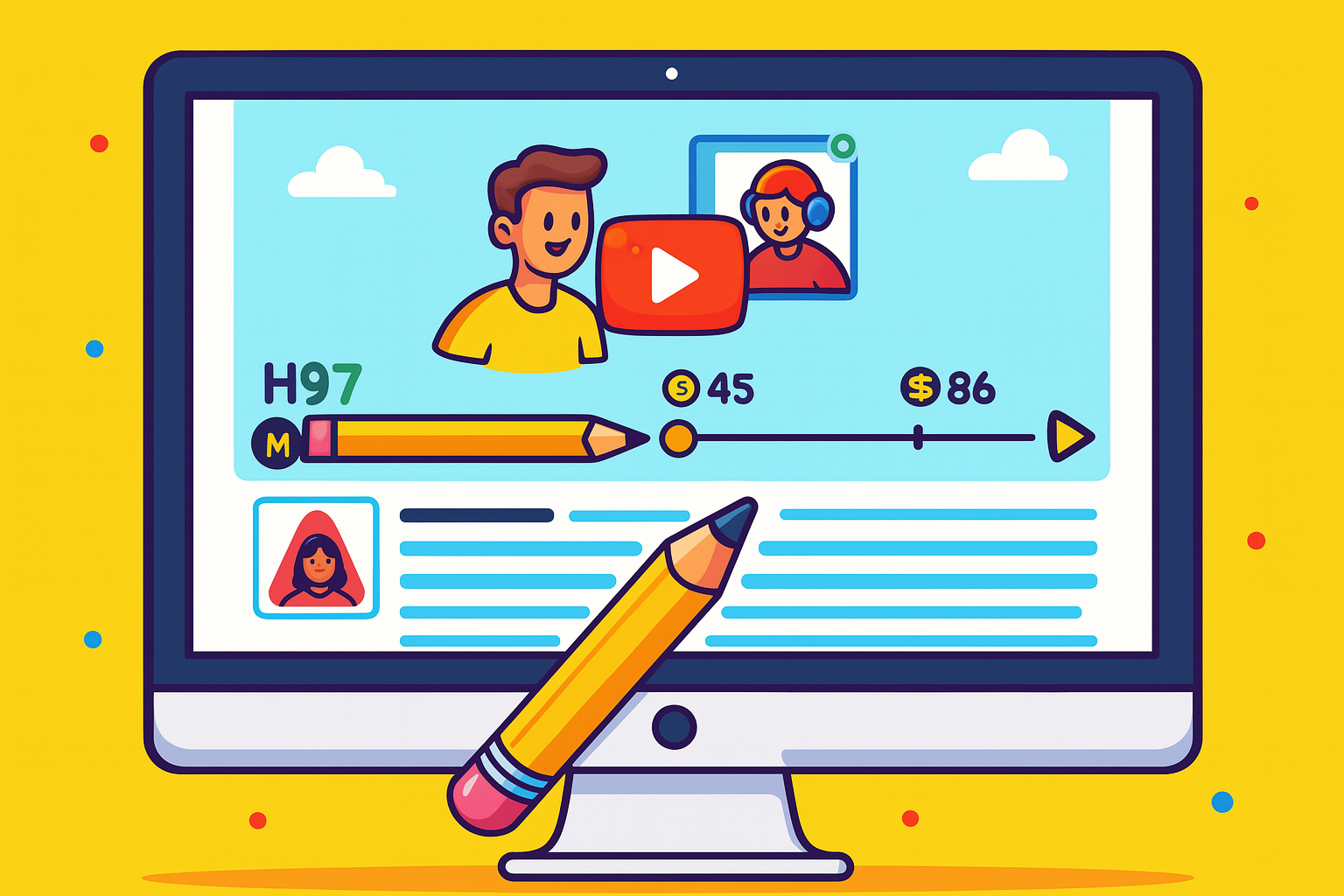
As you start exploring what animated business videos can do, it’s only natural for questions to come up. It's a world filled with creative possibilities, so getting a handle on the practical details—like how long a video should be or what you can expect to pay—is crucial for making smart moves for your brand.
This section is here to give you straightforward answers to the questions we hear most often. We'll skip the jargon and get right to the practical insights you need to move forward with confidence.
How Long Should A Business Animation Video Be?
There’s no magic number here—the ideal length for your animated video really hinges on its purpose and where people will be watching it. But there are some solid rules of thumb that will help you keep your audience glued to the screen.
For marketing or promotional videos—think landing page heroes, social media ads, or blog post intros—the sweet spot is between 60 and 90 seconds. That's just enough time to grab attention, outline a problem, present your solution, and wrap up with a clear call-to-action before you lose them.
If your video is more educational, like a detailed product tutorial or an internal training guide, you’ve got a bit more runway. These can comfortably run from 2 to 5 minutes. A word of advice, though: for really complex topics, it’s often better to create a mini-series of shorter, bite-sized videos. This feels less daunting and helps viewers actually absorb what you’re teaching.
How Much Does An Animated Business Video Cost?
This is the big one, and the honest answer is: it really depends. The cost of an animated video is shaped by a few key factors, and knowing what they are will help you set a realistic budget.
The main cost drivers are always animation style, video length, and overall complexity. A simple 60-second 2D motion graphics video using basic shapes and text might land in the low thousands. On the other end of the spectrum, a detailed 3D product animation with custom characters and complex scenes could cost significantly more.
Here’s a quick rundown of what moves the price tag:
- Style Complexity: 3D animation is almost always more resource-intensive than 2D. Even within 2D, custom character animation will cost more than a straightforward motion graphics piece.
- Illustration Detail: The level of detail in your visuals plays a big part. Are we talking simple icons or fully realized, textured worlds?
- Length: It’s simple math. A longer video requires more time for every stage of production, which increases the cost.
- Revisions: The number of feedback rounds can also influence the budget. A clear, solid brief from the get-go helps minimize expensive changes later on.
It’s better to think of animation not as an expense, but as an investment. You're creating a versatile asset that can work for you in marketing campaigns, sales decks, and training materials for years to come.
How Is Animation Different From A Live-Action Video?
While both are fantastic mediums, animation and live-action shine in different scenarios. The right choice boils down to your message and what you're trying to show. Animation's biggest superpower is making the abstract concrete and the impossible, well, possible.
Need to explain how your software’s algorithm works? Animation can bring that data flow to life. Want to show a microscopic biological process? Animation can take your audience on a journey inside the human body. It gives you absolute creative freedom to build worlds and scenarios that would be impractical, costly, or flat-out impossible to capture on film.
Live-action, on the other hand, is all about reality and human connection. It’s perfect for building trust with authentic customer testimonials, showing a physical product in the hands of real people, or capturing the genuine vibe of an event.
Here's an easy way to think about it:
- Animation is your go-to for visualizing concepts, processes, and ideas that you can't just point a camera at.
- Live-action is ideal for showcasing real people, physical products, and building a sense of authenticity.
What Is The Turnaround Time For A Typical Project?
Patience is a virtue, but we all know that in business, deadlines are king. For a standard 60- to 90-second animated business video, you can typically expect a turnaround time of 4 to 8 weeks, from the initial kickoff call to the final file delivery.
This timeline breaks down into a few key production phases:
- Discovery and Scripting (1-2 weeks): Kicking things off with strategy sessions, defining goals, and getting the script just right.
- Storyboarding and Illustration (1-3 weeks): This is where the visuals start coming to life, from rough sketches to final, polished style frames.
- Animation and Sound Design (2-4 weeks): The most labor-intensive part. Animators work their magic, and the voice-over, music, and sound effects are added.
- Revisions and Final Delivery (1 week): The final stretch for incorporating client feedback, making small tweaks, and rendering out the finished video.
The two biggest variables that can stretch or shrink this timeline are the complexity of the animation and the efficiency of your feedback. Intricate character work will naturally take longer. Likewise, providing clear, consolidated feedback at each stage is the secret to keeping things moving smoothly and on schedule.
Ready to create high-impact animated videos without the guesswork and long production timelines? Moonb provides a full creative department on-demand, giving you access to animators, scriptwriters, and strategists for a flat monthly fee. Streamline your production and get consistent, high-quality animated content that drives results.
Start creating with Moonb today!



